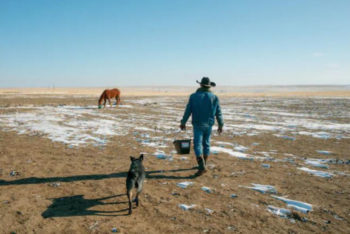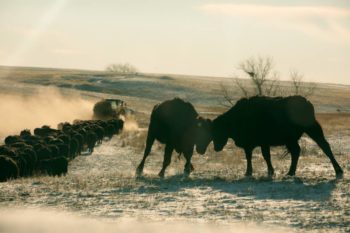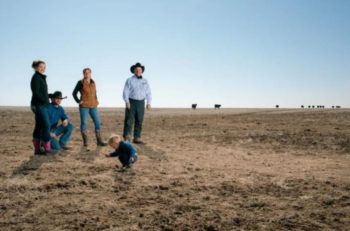
Ty Turecek feeds the horses on his family’s Colorado ranch, which includes several thousand acres protected in perpetuity through a conservation easement. (Matthew Staver for The Washington Post)
DEER TRAIL, Colo. — Through dusty binoculars, rancher Keven Turecek surveyed dozens of black Angus heifers grazing under a midday sun on the undulating plains. Real estate speculators from Denver frequently make offers for his expansive spread just 63 miles east of downtown. He keeps telling them: He’s not selling. Nor are his neighbors.
Turecek and six other local ranchers have signed legally binding agreements with land trusts and government agencies to permanently restrict most development on their property. Collectively, the agreements are protecting some 86 square miles of shortgrass prairie considered among the world’s most endangered ecosystems.
“From here to the horizon, that’s all conserved,” said Turecek, who, like his neighbors, received tax breaks and grants in exchange for the deed restrictions. “This will always be a ranch, whether we run it or someone else. They can’t plow it, they can’t build on it, and they can’t subdivide it.”
Across the West, a growing number of ranchers and farmers are seeking such “conservation easements” to stave off the big-box stores, self-storage complexes and residential construction consuming millions of acres of fertile open space. From Montana’s sagebrush steppe to New Mexico’s Central Flyway, the interest is so strong that state agencies and nonprofits are juggling lengthy waiting lists of applications. A Wyoming land trust funded in part by state appropriations typically has as many as 24 projects vying for review.
“There is huge demand,” said Jordan Vana, managing director of Montana Land Reliance. The organization, working with land trusts and government agencies in the state, closed deals in fiscal 2019 that preserved 71,000 acres — more than the other 49 states combined.
This push for “cows over condos,” as some call it, comes as the Trump administration increasingly greenlights industrial uses on public lands across the West. It has transcended political, geographic and economic lines, creating unlikely partnerships between conservative farmers and ranchers and liberal conservationists. Their shared goal is to safeguard areas that connect fragmented ecosystems, shelter endangered species, preserve soil that acts as a carbon sink and lock up water rights coveted by thirsty cities.
Such agreements currently protect about 5 million acres in Wyoming, Montana and Colorado. In 2017, researchers at Colorado State University found up to a $12 return for every $1 spent via state tax credits and a unique program that taps lottery proceeds.
Yet as easements proliferate across contiguous properties, concerns mount about whether taxpayer money should be expended on private land that may remain accessible only to the landowner. While advocates say the public benefits because deed restrictions preserve prime agricultural land that serves a greater good, hunters are particularly worried that prohibitions could affect the longevity of their pastime — and the permit fees they pay that help support state parks.
“Access is commonly cited as one of the top reasons people stop hunting — it’s harder and harder for them to find,” said Joel Webster, senior director of western programs at the Theodore Roosevelt Conservation Partnership in Missoula, Mont.
Conservation easements have been around for decades, encouraged by federal and state tax benefits. (California and New York were the first states to pass legislation.) Interest jumped sharply as development claimed at least 31 million acres of prime agricultural land between 1992 and 2012, according to a 2018 report from the American Farmland Trust. Nationwide, an estimated 40 million acres of natural habitat now fall under easements. A quarter of that is along the Eastern Seaboard.
Funding remains a major hurdle, however. After land trusts lobbied for additional support, Congress almost doubled money available to protect agricultural land in the 2018 farm bill to $450 million a year. Even so, the U.S. Agriculture Department can fund only 30 percent of the applications it receives annually for its easements program, said program manager Jerome Faulkner.
The impact of easements in agricultural-rich regions extends well beyond individual landowners. If farm and ranch operations cease, small towns struggle to support stores that sell machinery, groceries and gas. Just as important, advocates say, is how easements help sustain a generations-old heritage under siege from rampant development.
“There are a lot of communities in the state . . . reaching that economic tipping point,” said Tony Caligiuri, president of Colorado Open Lands. “If we can’t guarantee a certain amount of land will remain in agriculture, the whole area around it will start to evaporate.”
Caligiuri’s nonprofit is handling 100 conservation easement applications covering 240,000 acres — more than the total for Colorado’s 41 state parks. About 80 percent of the prospective deals involve farms and ranches, said Caligiuri, whose work is influenced by personal history. As a child, he watched as his father had to sell three different farms in southeast Pennsylvania, in part to escape homeowner complaints as suburban sprawl surrounded each operation.
The complicated agreements often take years. Few appraisers are trained to assess such deals. Scientists and others must determine that the land provides crucial habitat or holds historical or recreational value before an owner can qualify for state or federal funding.
“We’ve absolutely lost projects,” said Erik Glenn, executive director of the Colorado Cattlemen’s Agricultural Land Trust. “A landowner might come to us and talk about their vision for the land, and it meets the requirements — it might even be in a high priority conservation zone. [Then] we say, ‘We can’t do anything for three to five years.’ ” The response? “That’s not going to work for me.”
In New Mexico, retired school administrator Johnny Pack joined three neighbors to place an easement on 600 acres that includes riparian wetlands a few miles north of Bosque del Apache National Wildlife Refuge. The deal took a decade as the parties applied and reapplied for federal funding for wetland preservation from the U.S. Fish and Wildlife Service. It finally concluded in 2016.
“I didn’t know if it was going to work until the very end,” said Pack, who owns just over half of the total acreage. Between tax breaks and funding raised by the land trusts that now hold the easement, he realized as much per acre — about $1,300 — as he expects he would have gotten from an outright sale.
“It was the best of both worlds,” he said. “I could recoup money and put land into an easement that protects birds.”
As the number of conservation easements multiplies in western states, so do concerns about their long-term stewardship.

Ty Turecek delivers a line of feed for the cattle on the Stacked Lazy 3 Ranch in Deer Trail, Colo. (Matthew Staver for The Washington Post)
“We’re in a mad rush to put new lands under easement, but what lingers in my mind is what happens 20 or 30 years from now when easements turn over to a new generation or to buyers who weren’t there when the easement was put on,” said Drew Bennett, a professor in the private lands stewardship program at the University of Wyoming.
Several hundred easements in Colorado were abandoned over the last 15 years when the land trusts that held them dissolved. Until the coronavirus forced lawmakers home, the legislature was working on a measure that would allow the state to find the orphaned agreements a new home and provide compensation to easement holders swept up in past abuse.
Keven Turecek and his wife, Sandi, moved forward in 2011 with little hesitation. “We’ve watched a lot of good farm ground and good ranch ground go under development,” she recalled recently from a muddy pickup, as the couple and their dog, a blue heeler named K.D., made daily rounds to check on cattle.
The Tureceks combined land their families have worked near Deer Trail for more than a century with other parcels and formed the 35,000-acre Stacked Lazy 3 Ranch, which they plan on turning over to one of their sons. About 5,400 acres are covered by the easement they forged with Colorado Cattlemen’s Agricultural Land Trust and Great Outdoors Colorado, and the $1 million they earned from giving up development rights there will benefit their other three children.

Sandi and Keven Turecek, center, sought to permanently protect part of their 35,000-acre ranch from development through a conservation easement. They plan to turn the land over to their son, Ty, who will continue its cattle operation with his wife, Page, and young son, Tuff. (Matthew Staver for The Washington Post)
Grassland birds, among the world’s most rapidly declining avian species, abound here, as do mountain lions, deer and pronghorn antelope. The Tureceks take pride in the health of their ranch, and they’ve won accolades for their efforts to convert poorly managed areas back to native grass, build miles of terraces so the soil will better hold water, restore riparian areas and plant trees to prevent erosion. Their Angus cattle are rotated among pastures so the land can recover.
“Conservation easements are preserving not only a way of life on working farms and ranches — that is only 2 percent of the population,” Sandi Turecek noted. “But they feed the other 98 percent, and it’s in everyone’s best interest to keep farmers and ranchers on their farms and ranches.”
By Jennifer Oldham – Washington Post